2007 VOLKSWAGEN GOLF PLUS tow
[x] Cancel search: towPage 195 of 541
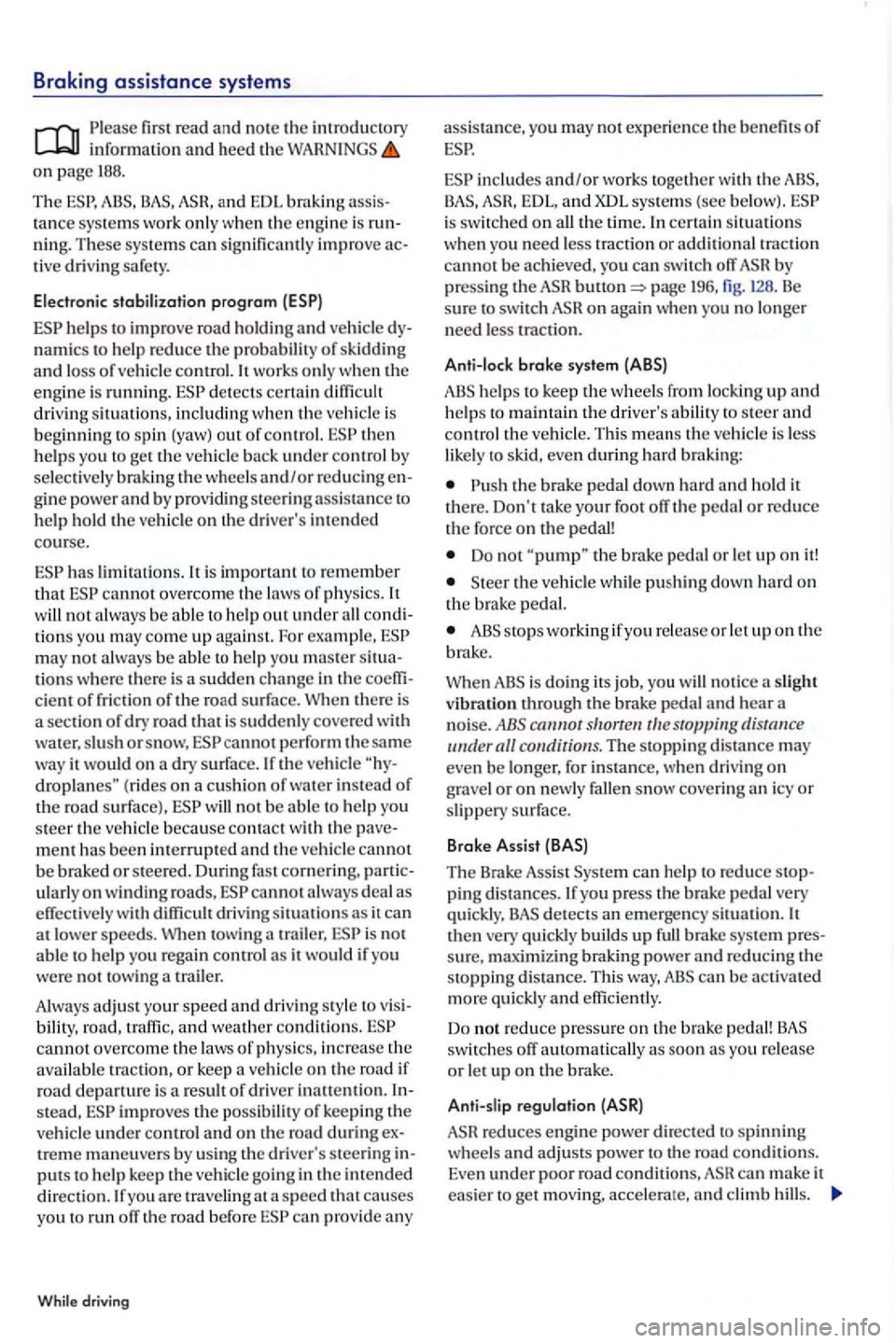
Braking assistance system s
fir st read and n o te the introductory information and heed the
on page
T he and EDL braking tance system s work onl y w he n th e engine is ning. These sys te m s can sig nificantl y improve
vehicle namics to help reduce the probability of skidding and loss o f vehicl e control. works only w hen the engine is running. driving situations, including w hen the veh icle is beginning to spin (yaw) out of control.
gin e power and by providing steering assistance to help hold the ve hicle on the driver's intended
course.
has limitation s.
will not always be able to help out under all tions you m ay come up against. For example, may no t a lways be able to hel p you mas te r tions w he re there is sudde n change in the
cannot perform the sa me
way it would on a dry surface. the vehicl e
cornering. ularly on winding road s, cannot always deal as
e ffectiv ely wi th diffi cult drivin g situations it can
a t lower speed s. When towin g a is not able to help you regain control as it would if yo u were not towing a trailer.
Alway s
adjust your speed bility, road, cannot overcome the laws of phys ics, increa se the available
stead, improves the possibil ity o f keeping th e
vehi cle under control and o n th e road during treme maneuvers b y using th e driver's s teerin g puts to help keep the vehicle going in the int ended direction .lf you a re tra velin g at a speed that causes yo u to run off th e road before can provide any
EDL , and XDL syste m s (sec be lo w). is switc hed on all the tim e. certain situati ons
w he n you need less traction or additional tract ion cannot be achieved, you can swit ch off by pressing page 196, fig. l28. B e
s
ure to switch ASR on again when you no longer
need less traction.
Anti-lock
brake system (ABS)
ABS helps to keep the wheels from l ocking up and helps to maintain t h e driver's ability to steer and control the vehicle . Thi s means the vehicle is less lik ely to skid, even during hard
th e brake pedal down hard
Do not the brake pedal or letup on it!
S teer the vehicl e while pushing down hard on the brake pedal.
ABS sto ps working if you re lease or let up on th e brake.
When is doing i t s job, you will notice
noise. T he stopping di stance may even be lo nger, for instance, when dri ving on
pin g distances.lfyou press the pedal very quickly, BAS detects an e m ergency situ ation.
pedal! BAS
s w itches off automaticall y as soon
reduces en gine power d irected to spinning wheels and adjus ts power to the road conditions.
Eve n under poor ro ad conditions,
Page 200 of 541
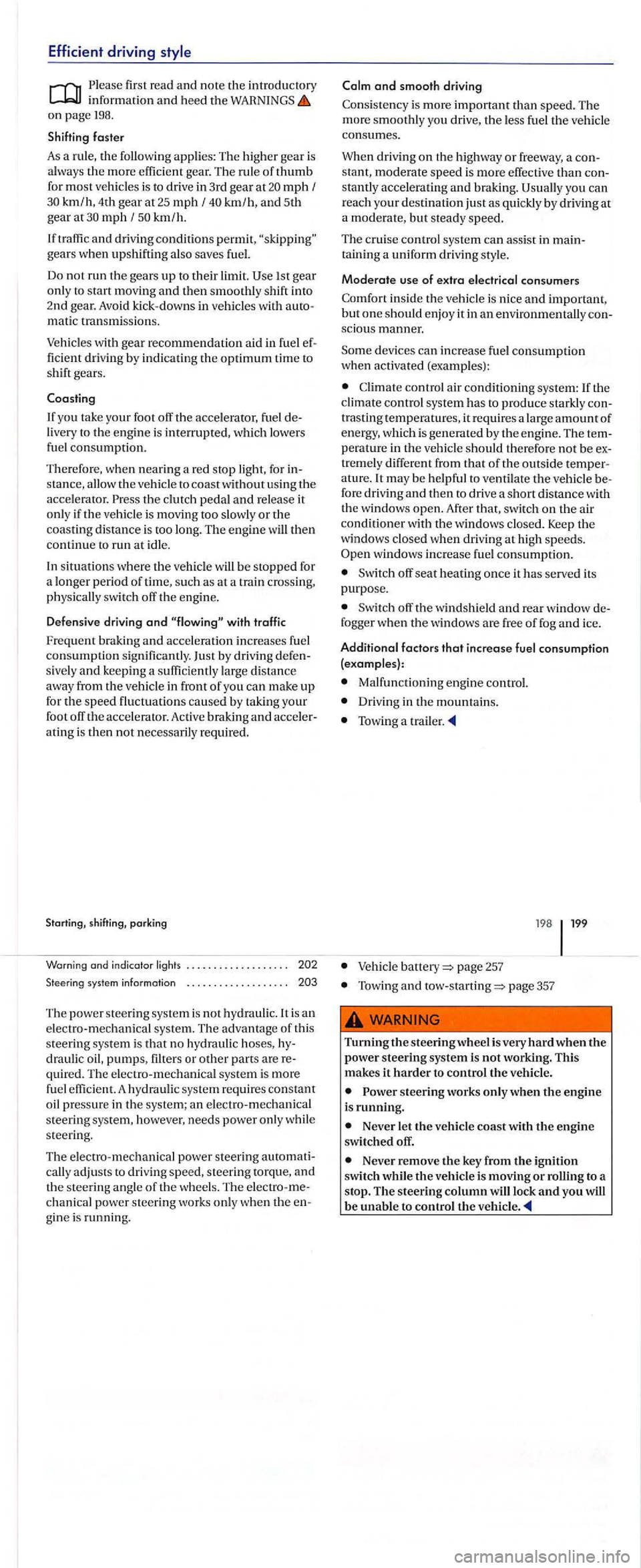
Efficient driving
Please information and heed the on page 198.
Shifting faster
As a rule, the following applies: The higher gear is
a lways the more efficient gear. The rule of thumb for most vehicles is to drive in 3rd gear at mph f km/h, 4th gear at 25 mph f km/h, and 5th gear at mph f km /h.
If
and driving conditions permit, gears when upshifting also saves fuel.
Do
not run the gears up to their limit.
mati c transmissions .
Vehicles with gear recommendation aid in fuel fic ient dri ving by indicating the optimum time to shift gears.
livery to the engine is interrupted, which lowers
fuel consumption.
T herefore, when nearing a red stop light , for s tanc e, allow the vehicle to coast without using the accelera tor. Press the clutch pedal and release it only if the v ehicle is moving too slowly or the coasting distance is too long. The engine will then continue to run at idl e.
In situati ons
where the vehicle will be stopped for
a longer period of time, such as at a train cros sing,
physically switch off the engin e.
D efens ive driving
and with traffic
Fre
quent braking and accel eration increases fuel consumption sign ific antly. Just by driving sivel y and keeping a su fficiently large distance away fro m the vehicle in front of you can make up for the speed fluctuation s caused by taking your foot off the accelerator. Active braking and ating is then not necessarily required.
system information
The power stee ring syste m i s not hydrauli c.lt is an electro-mechanical syste m. The advantage of this
s te ering system is tha t no hydra uli c hoses, draulic oil, pumps, filters or other parts are quired . Th e e lectro-m echanica l system is more fue l effi cient. A hydraulic system requires constant oil pressure in the syste m; an electro -mechanical
s teerin g sys tem, however, needs power only whil e
s teering.
Th e el
ectro-mechanical power steering
chanical power steering works only when the gin e is running.
and smooth driving
Consistency is more important than speed. The more smoothly yo u drive, the less fuel the vehicle consumes.
When driving on the highwa y or freeway, a
stantly accelerating and braking. you can r each your destinatio n just as quickly by driving at a moderate, but steady speed.
The c rui se control syste m can a ssis t in
sciou s manner.
Some dev ices can increase fuel consumption when activated (examples):
C limate control air conditioning system:
trasting temperatures, it requires a large amount of energy, which is generated by the e ngin e. T he
tr emely different from that of the outside
windows increase fuel consumption.
Switch off seat heating once it has served its
purpose.
Sw itch off the windshield and rear window
Malfunctioning engine control.
Driving in the mountains.
Towing a trailer .
page 257
Towing and page 357
Turning the steering wheel is very hard when the power steering system is not working. This makes it harder to control the vehicle.
steering works only when the engine is running.
Never let the vehicle coast with the engine switched off.
Never remove the key from the ignition
switch while the vehicle is moving or rolling to a
stop. The steering column will lock and you will be unable to control the vehicle.
Page 207 of 541

detec te d in segment. @ a re o b ehind t he
firs t read and no te the introductory inform ation and heed the on page206.
Th e
Parking System is an enhancem ent of th e Park Distance page 207.
Functio n
Fig . 1 3 5
The area s scanned b y th e sensors in fron t of and
b e hind the veh icle are disp la yed in the screen of the facto ry-install ed sound sys te m or navigation
sys te m . obstacles are
p age 207-. is autom atically
a c tiva te d .
an area se le ct io n bu tto n on th e factory-ins talled rad io o r navi-
Manuall y deactiva te dis play: gat ion sys te m.
o n To uch the fu nct io n butto n on th e screen.
Drive
fas te r than 6-9 mph (10-15 km/h) . Automatic ally deactivate dis pl ay: ve hicle s w ith Hear Assis t, s hift into page 210 . The p lay swi tc hes to th e ima ge.
Scanned areas
The obsta cl e detection area exte nds up to about 4
f t. (120 em) in front of the ve hicle and up to about 2
ft. (60 em) to e ither fig. 135 a rea hind th e ve hicl e is scanned u p to a dis ta nce of about 5 ft. (160 em ) and about 2ft. (60 em ) to either
Screen display
T he dis p lay sh ows the scanned area in seve ra l m ent s. The closer th e ve hicl e ge ts to th e obstacl e,
th e closer the segm ent m ove s toward s the ve hicle
i n th e fig. 13 4 135 the nex t- to -la st segm ent is dis p laye d, the
collis io n zone has be en reac hed. Sto p!
Di s
tance be twe en vehicl e and obstacl e Audible signal For color disp lay s: Seg ment color if an obstacle is detected
F ront: fr o m about l ft. (3 1 em) to 4 ft.
( 1 20cm)
Beep Ye llow
Rear : fro m about l ft. (31 em) to 5 ft. (160 em)
From about 0 ft. tone Hed or
While driving
Page 212 of 541
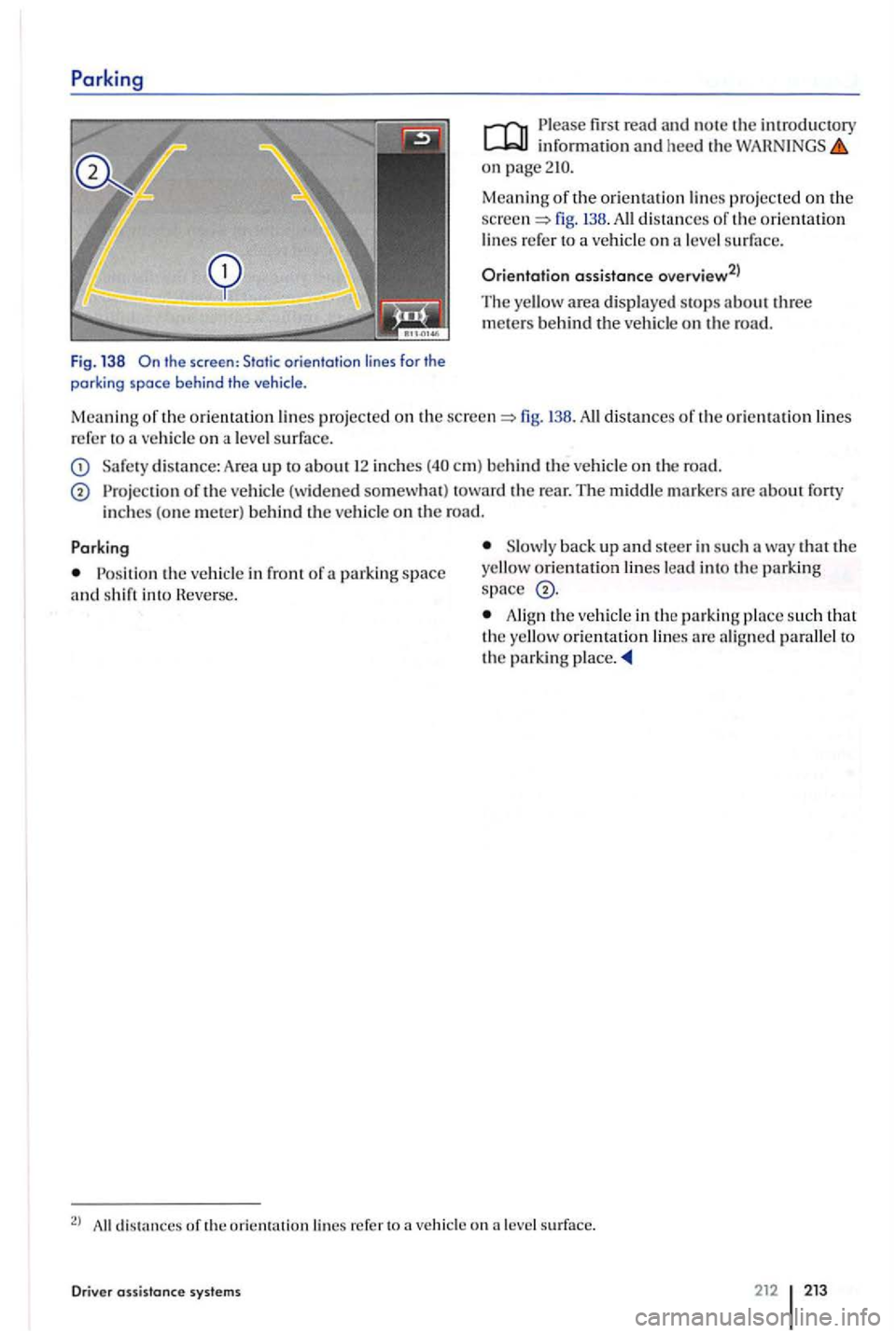
Parking
Fig. 138 the screen: Static orientation lines for the
parking space behind the vehicle.
firs t read and note th e introductory informatio n an d heed the on
three mete rs be hind the ve hicle on the road.
Mea
ning of th e orient ation lines pro jecte d on the screen=> fig . 138 . All distances of th e orientat ion lin es refer to a vehicle on a leve l surface.
Sa fety dista nce: Area up to about 12 i n ch es
of the vehicle (w idened somewhat) toward the rear. The middle mark ers are about forty
inches (one m ete r) behind th e ve hicle on the road.
way that the yellow orientatio n lines lead i nt o th e parkin g
s pace
Alig n the v ehicl e in the parkin g place su ch tha t
th e yellow orientatio n lines are aligned p aralle l to
the park ing place.
All di stance s of th e orie nt ation lin es refer to a vehicle on
Page 219 of 541
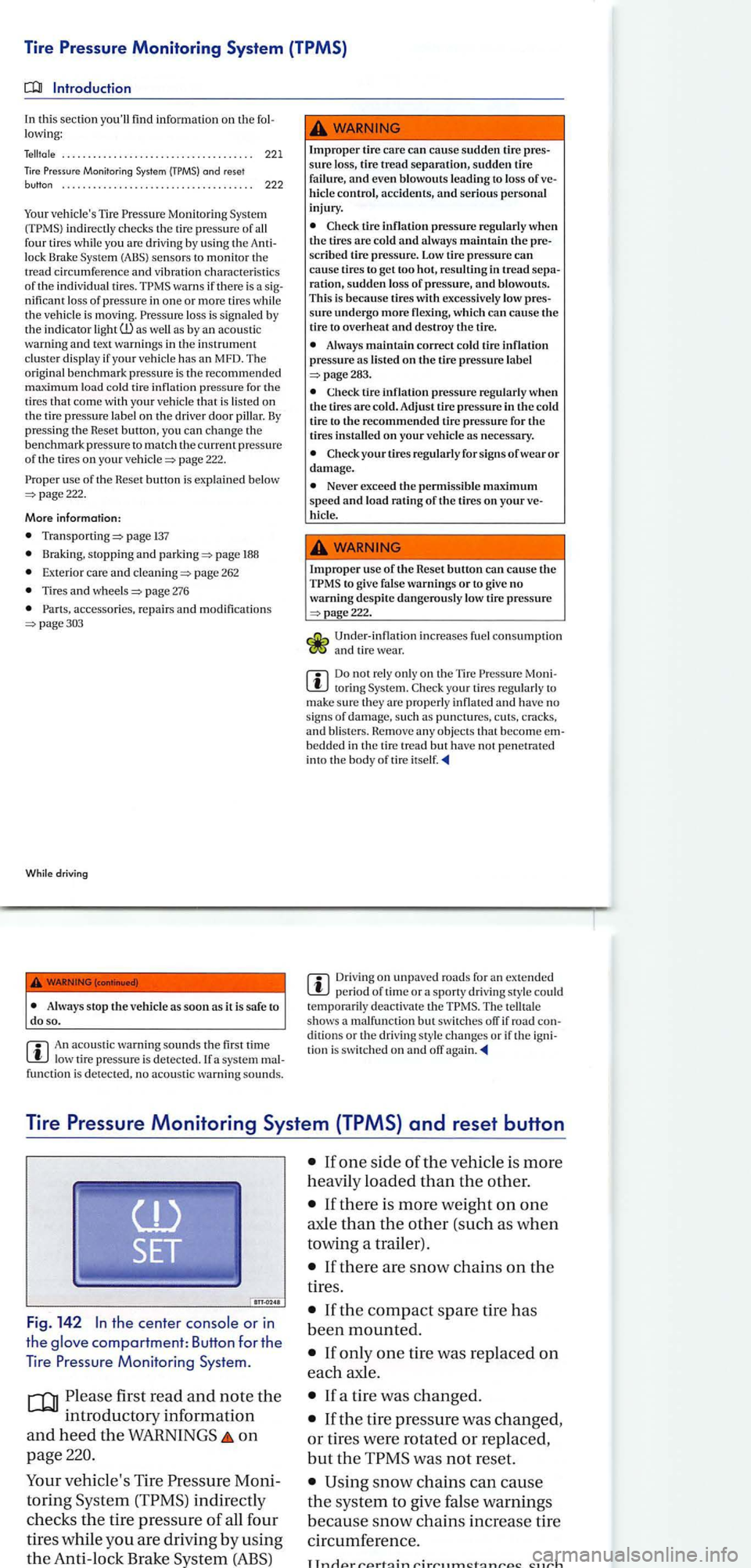
Tire Pressure Monitoring System (TPMS)
this section you'll find informati on on th e lowing:
. . . . . . . . . . . . . . . . . . . . . . . . . . . . . . . . . . . . . 221
Monitor ing System
Monito ring Sys te m indirectly c hecks the tire pressure of all
f our tires while you are driving by us ing the lock Brake Syste m (ABS) sensor s to monitor the
tr ea d circumf erenc e and vibration ch arac te ris tics of the indi vidua l tir es. warns if there is a nifi cant loss of pres sure in one or more tires while
the vehicl e is mo vin g. loss is s ig nale d b y
the ind icato r light as by an aco usti c
wa rni ng and text warnin gs in the in strument clu ster di spla y if your ve hicle has an MFD. The
origina l b en chmark pre ssure is th e recommended
m axi mum load cold tire inflati on pressure for the tire s that come with your vehicle that is lis te d on
th e tire pressure lab el on the dri ver door pill ar. By press ing the Reset button , yo u can ch ange the
b enchmark pressure to match th e c urr ent pressure of the tir es on you r page 222.
use of the Heset butto n i s explained below 222.
More informa tion:
page 137
Bra king, stopping and page 188
Ext e rior care an d page 262
page 276
pa ge303
Whil e driving
An acoustic warni ng sounds th e first time low tire pressure is detec ted. a system
Improp er tire care can cause sudden tire sure loss,
hicle control, accidents, and serious personal
injury .
tire inflation pressure regularl y when the tires are cold and alway s maintain the scribed tire pressure . Low tire pressure can cause tires to get too hot, res ultin g in tread ration, sudden lo ss of pres sure, and blowout s.
Thi s is because tires with excessively low
sure undergo more flexi ng, which can cau se the tir e to overheat and destroy the tire.
Always maintain correct cold tire inflation pressure as listed on the tire pressure label
Check tire inflation pressure regularl y when the tires are cold. Adjust tir e press ure in the cold
tir e to the recommended tire pressure for t11e tires installed on your vehicl e as necessary.
Neve r exceed the permissi ble maximum speed and load rating of the tires on your hicl e.
Imprope r us e of the Reset button can cause the to give false warnings or to give no
warning des pite dangerou sly lo w tire pressure
page222.
Und er- inflat ion increases fue l con sumptio n and tire wear.
to ring Syste m.
bedde d in the tir e tre ad but have n o t penetrated
int o the body of tire
Driving on u npaved roads for an extended
The te lltal e
s h ows a malfunc tion but switch es orr if road dit io ns or th e drivin g sty le c han ges or if th e tio n is switch ed on and orr
Tire Pressure Monitoring System (TPMS) and reset button
the center or in
the compartment: Button for th e
T
ire Pressure Monitoring System.
first r ead and note the
introductory informatio n
and heed the WARNINGS on
page
ve hicle's Tir e Moni
torin g
indirectly
c h ec ks
the ti re pressure of al l four
tire s while yo u are drivin g by us
ing
the Anti -loc k
If there is more weight on one
axle than the other (such as when
towin g a trailer) .
Page 260 of 541
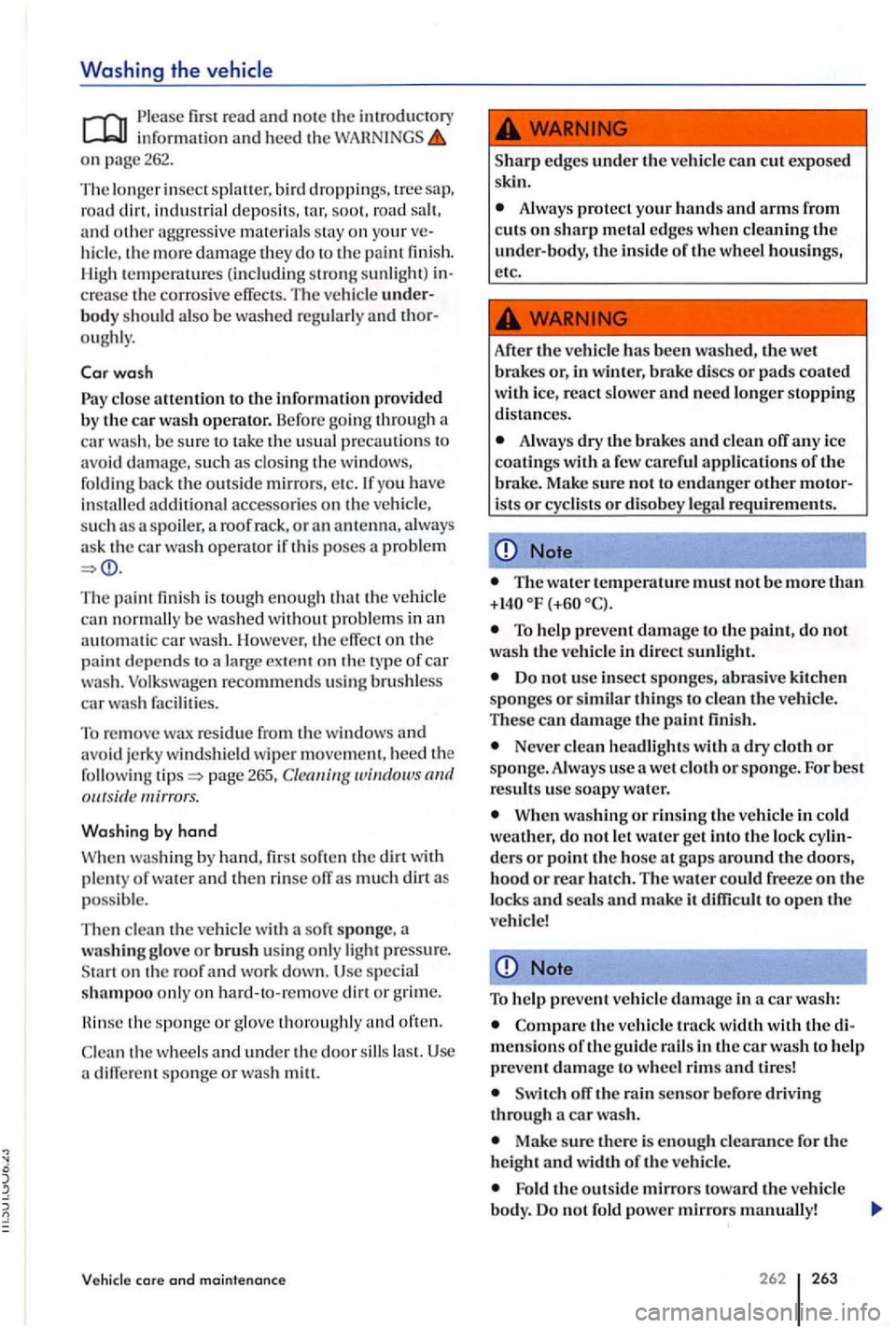
Washing the
fir st read and note th e in formatio n and heed th e on page 262.
The lo nge r insect splaue r, b ird droppings. tree sap,
road din, indu strial depo sits, road and o ther aggressive materials sta y on your ve
hicle , more damage they do sunlight ) crease the corros ive effects. The vehicle underbody sh o uld als o be was hed regularl y and thor
o ughly.
to the information by the car wash operator. Before going through a
ca r wash , b e s ure
you have installed addition al accessorie s on the vehicle, su ch as a spoiler, a roof rack, or an ant enna, alway s
a sk th e car was h opera tor if thi s po se s problem
The paint finish is
dep end s a la rge exte nt on th e rype of ca r
was h. Volk swagen recommend s using brush le ss
ca r w as h faciliti es.
' l b
rem ove wax res idu e from th e windows and
avoi d jerky wind shi eld wip er move m ent , heed the
f ollow ing page 265, outsi de
w ith
on the roof and work down. Usc sp ec ia l shampoo only on hard-to -remove or grim e.
Hinsc
different sponge or wash mill.
edges under the vehicle
Always protect your hands
Alway s dry the brakes and clean off any icc
coatings with a few caref ul appli cations oftlte brake. Make sure not to endanger other motoris ts or cyclists or disob ey lega l requirement s.
Note
The water temperature mus t not be more than
To help prevent damage to the paint, do not wash the vehicle in direct sunlight .
Do not use insect sponges, abrasive kitchen
s ponges or similar things to clean the ve hicle .
These can damage the paint finish.
Neve r clean headlight s with a dry cloth or sponge. Always use a
When washin g or rinsing the vehicle in cold
weather, do not let water get into the lock cylin ders or point the hose The water could freeze on the locks and seals and make it difficult to open the vehicle!
Note
To help prevent vehicle damage in a car wash:
the vehicle track width with the di
men sion s of the guide rail s in the car wash to help prevent damage to wheel rims tires!
off the rain sensor before driving
through a wash .
Mak e sure there is enough clearan ce for the height and width of the ve hicle.
Fold the outside mirrors toward the vehicle
body. Do not fold power mirrors manually!
262 263
Page 271 of 541
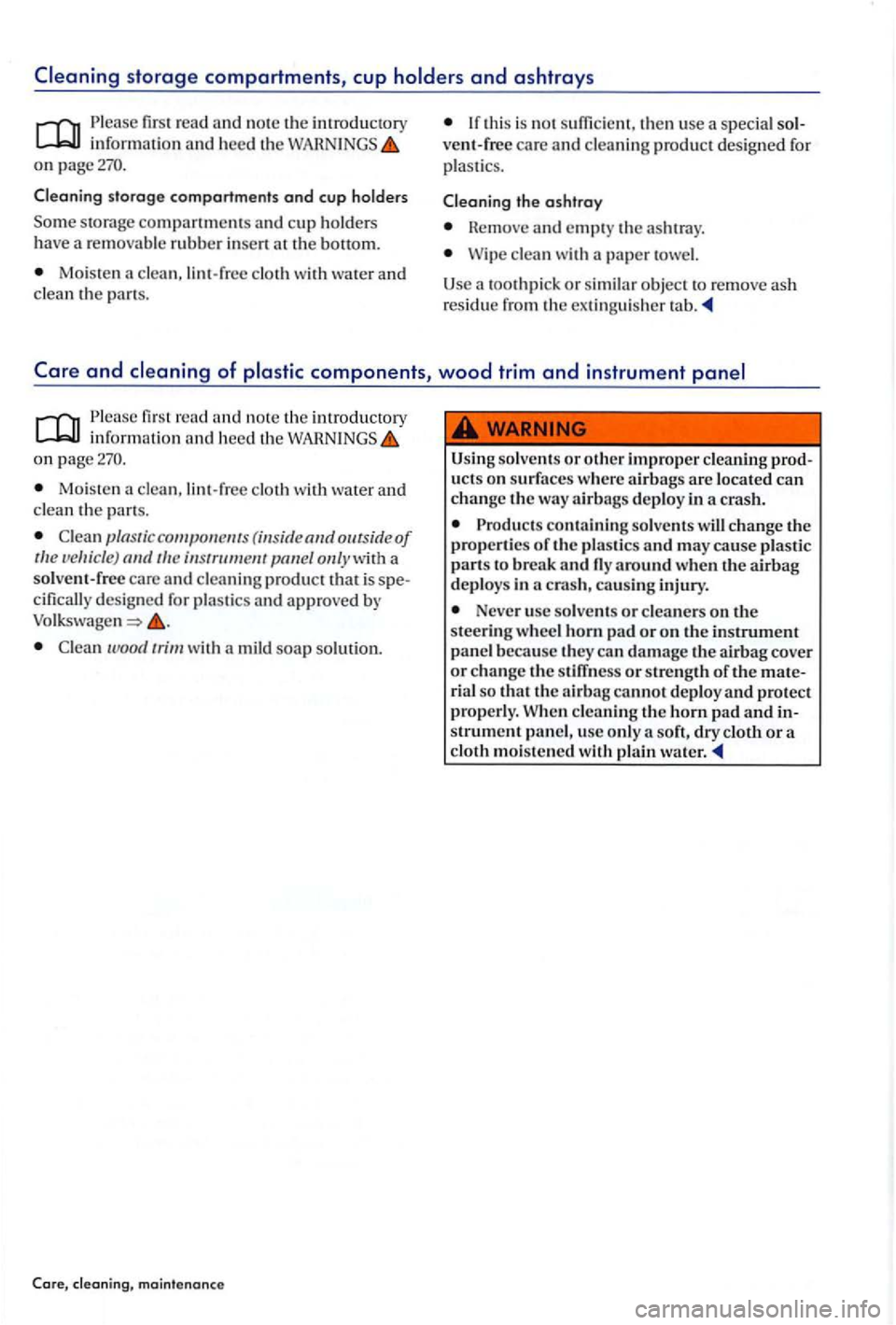
on page
Cleaning storage compartments and cup ho lders
Some storage compartmen ts and cup h old ers
have a remov able rubber inse rt at the bottom.
Mo is ten a clea n, lint -free cloth with water and
clean th e pa rt s.
If thi s is not then use a special vent -free care an d clea ning produ ct d es igned for plastics.
Cleaning the ashtray
Re mo ve and empty th e ashtray.
Wipe clean with a paper towel.
Use a toothpick or s imilar objec t to remove ash res idu e fr o m the ex tingui sh er
Care and
read an d no te the introdu ctory information and heed the on page
Mo is te n clea n, lint -free cloth with water and
clean the part s.
Clea n on/ywith a
so lvent-fr ee care an d clea ning product that is cifically desig ned for pla stics and approve d
Clean wood trim with mild soap solution.
Core, cleaning, maintenance
Usin g solven ts or o ther improper cleaning
Never usc solve nts or cleaners on the steerin g wheel horn pad or on the in strument panel b eca use they ca n damage the airbag cover or change the rial so that th e airbag cannot deploy and protect
properly. When cleaning the horn pad and strument panel, u se only a soft, dry cloth or a
cloth moistened with plain
Page 273 of 541
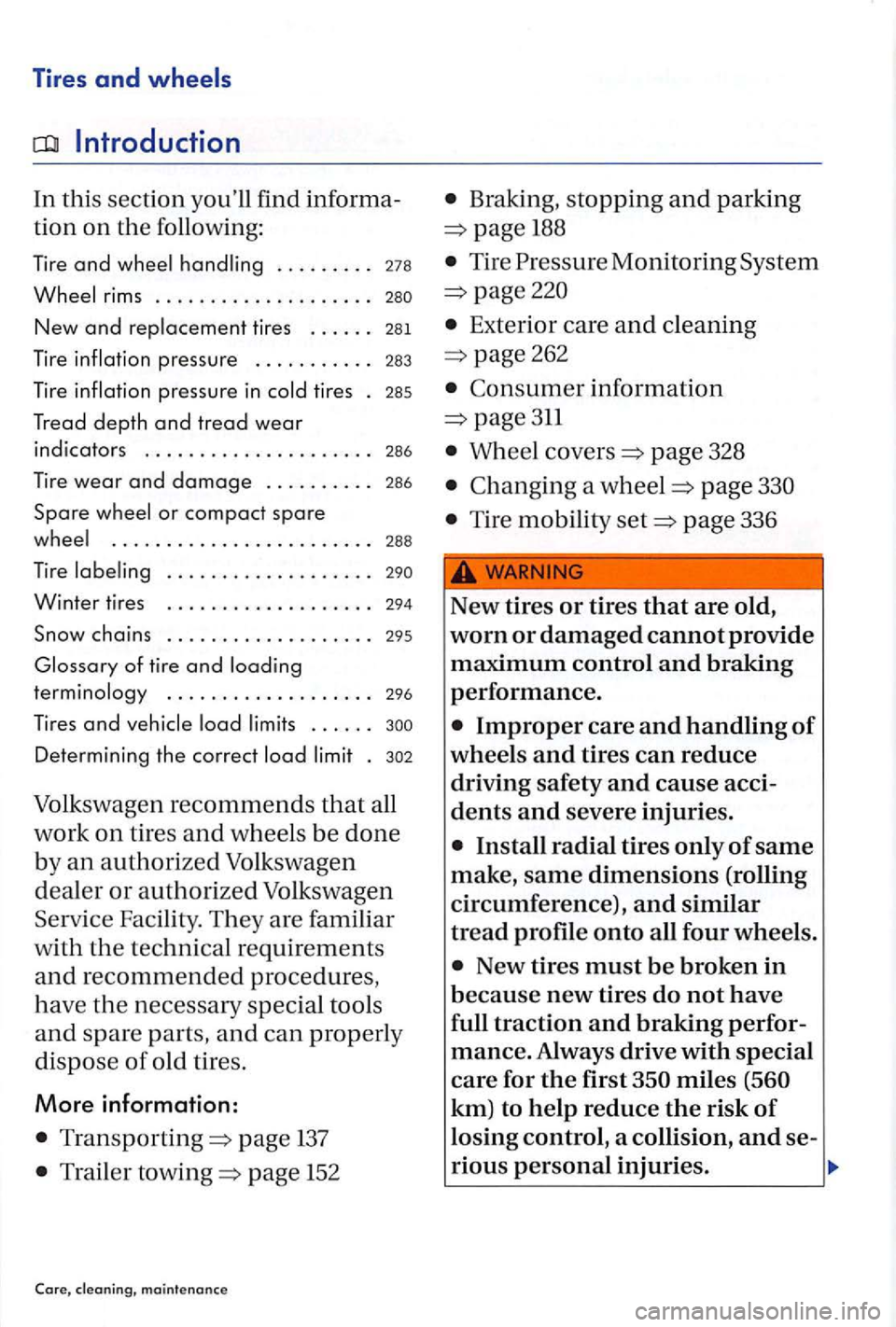
Tires and wheels
Introduction
In this section you'll find informa
tion on th e following:
Tire and . . . . . . . . . 278
New and tires . . . . . . 281
Tire
tires . 285
Tread depth and tread wear
indicators . . . . . . . . . . . . . . . . . . . . . 286
Tir e wear and damage . . . . . . . . . . 286
Spare or compact spare
....... ................. 288
Braking, stopping and parking
188
Tire Pressure Monitoring System
Exterior care and cleaning
page262
Consume r information
Wheel covers page 328
Changing a wheel page
T ir e mobili ty page 336
Tire ...................
Winter tires . . . . . . . . . . . . . . . . . . . 29 4
Snow chains . . . . . . . . . . . . . . . . . . . 295
of tire and
. . . . . . . . . . . . . . . . . . . 296
Tires and . . . . . .
Determi ning the correc t
page 137
Trailer towing page 152
Core, maintenance
New tires or tires that are old,
worn or damaged cannot provide
maximum control and braking
performance.
New tires must be broken in
because new tires do not have
full traction and braking perfor
mance. Always drive with special
care for the first